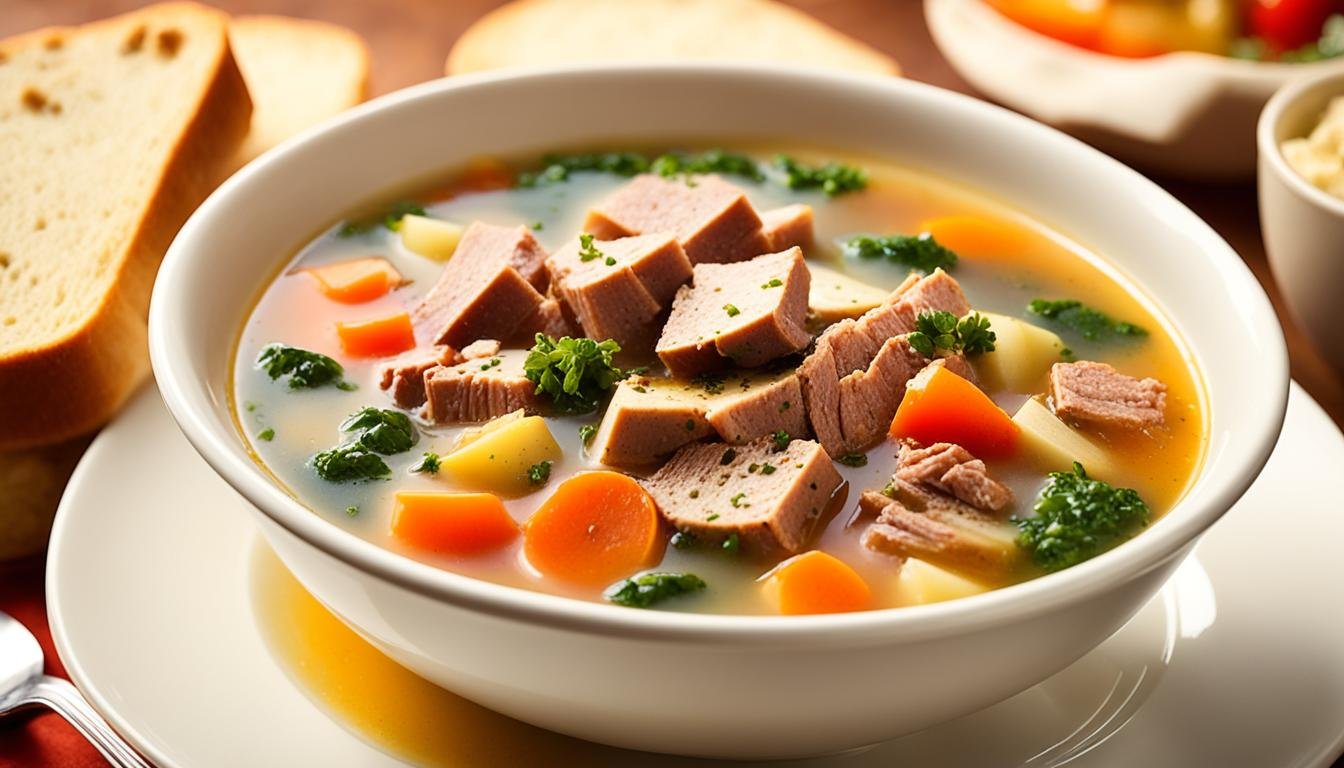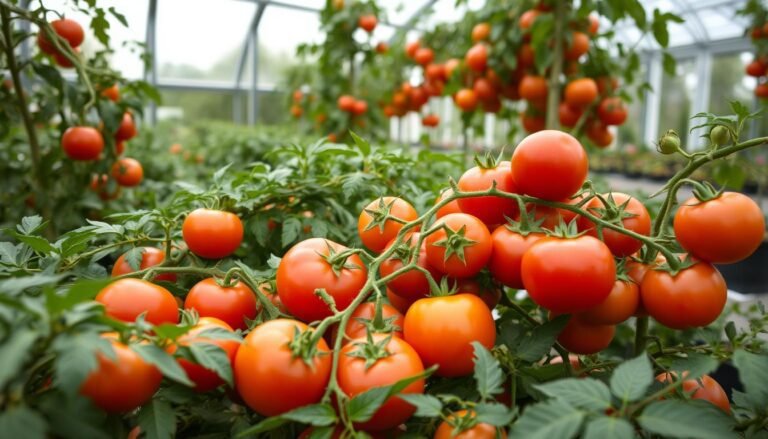Have you ever wondered what stories lie behind the mouthwatering dishes that have been passed down through generations? As a captivating culinary explorer, I’m excited to embark on a journey that uncovers the rich flavors and cultural significance of traditional food. From uncovering the narratives of ancestral dishes to celebrating the vibrant regional cuisines that make up the tapestry of American gastronomy, this article will take you on a flavorful adventure that evokes nostalgic comfort and nourishes the soul.
Key Takeaways
- Discover the stories behind heritage recipes and ancestral dishes
- Explore the diverse regional culinary traditions across the United States
- Uncover the art of heirloom cooking and the preservation of cultural gastronomy
- Delight in the flavors of local delicacies and the tapestry of ethnic cuisines
- Rediscover the comfort and nostalgia of traditional food
Exploring the Flavors of Heritage Recipes
The world of heritage recipes is a captivating tapestry woven with the threads of cultural identity and culinary traditions passed down through generations. Each traditional food dish tells a story, a narrative that unveils the essence of a region’s culinary heritage. As we delve into the flavors of these ancestral dishes, we uncover the fascinating tales that have shaped the evolution of regional cuisine.
Uncovering the Stories Behind Ancestral Dishes
From the soulful comfort foods of the American South to the bold, fragrant spices of global cuisines, every traditional dish carries with it a unique history. These ancestral recipes have adapted and transformed over time, reflecting the preferences and creativity of diverse communities. By exploring the stories behind these dishes, we gain a deeper appreciation for the rich tapestry of cultural gastronomy.
Celebrating Regional Culinary Traditions
The vibrant tapestry of regional culinary traditions is a true testament to the enduring power of heritage recipes. These time-honored dishes have become the cornerstone of cultural identity, preserving the essence of home and family. As we celebrate the diversity of these regional cuisines, we uncover a world of flavors that nourish both the body and the soul, reminding us of the importance of preserving our culinary heritage.
| Traditional Dish | Region of Origin | Key Ingredients | Significance |
|---|---|---|---|
| Minestrone | Italy | Leafy greens, whole grains, legumes, vegetables | A hearty, nutrient-dense soup that reflects the simplicity and health benefits of traditional Italian cuisine. |
| Oden | Japan | Daikon radish, konbu seaweed, proteins | A comforting, slow-cooked dish that showcases the umami flavors and cultural traditions of Japanese gastronomy. |
| Pozole | Mexico | Hominy, pork, chilies, garnishes | A vibrant and flavorful stew that celebrates the indigenous ingredients and culinary heritage of Mexico. |
As we explore the flavors of heritage recipes, we are transported to the heart of cultural gastronomy. These ancestral dishes not only nourish our bodies but also feed our souls, connecting us to the rich tapestry of culinary traditions that have stood the test of time.
Preserving Cultural Gastronomy Through traditional food
Across the globe, traditional food plays a vital role in preserving the rich cultural gastronomy of communities. These time-honored dishes not only tantalize our taste buds but also serve as a powerful connection to the past, present, and future of diverse culinary landscapes. By embracing the preparation, consumption, and celebration of these ancestral recipes, we can safeguard the heritage and traditions that have been passed down through generations.
The UNESCO Representative List of the Intangible Cultural Heritage of Humanity recognizes 30 food and drink-related traditions, underscoring the importance of these culinary practices in preserving cultural identity. Traditional recipes, with their unique flavors and techniques, help to preserve the history and habits of the people who cooked them. As research from the University of Oxford has shown, the more we share food with others, the more likely we are to feel content and satisfied with our lives.
Sadly, the influence of Western diet culture has transformed food from a cherished, communal experience into something to be “weighed and measured,” rather than valued and enjoyed. To counteract this trend, we must actively engage with and preserve our cultural gastronomy. This can be achieved through a multifaceted approach, involving education, community participation, government support, and the harnessing of technology.
From Texas to Singapore, the preservation of culinary traditions is crucial in safeguarding the cultural identity of communities. As the second-most diverse state in the U.S., Texas boasts a rich tapestry of Hispanic/Latino and Asian influences, which are reflected in its vibrant food culture. Yet, the emphasis on high-skilled labor in major cities like Austin poses a risk for the loss of authentic foods, as younger generations opt for careers over traditional cooking.
Similarly, the hawker culture in Singapore is declining as older generations age and younger ones pursue different paths. To combat these threats, we must educate the younger generation in traditional cooking techniques, encourage local community involvement, and leverage technology to record and share these culinary treasures. Only by doing so can we ensure that the flavors and stories of our cultural gastronomy endure, enriching our lives and those of future generations.
The Art of Heirloom Cooking
Delve into the captivating world of heirloom cooking, where traditional food preparation methods and treasured family recipes come together to create culinary masterpieces. Explore the time-honored techniques that have been refined and passed down through the generations, revealing the artistry and dedication that go into crafting these beloved dishes.
Embracing Time-Honored Techniques
Heirloom recipes often come with unique methods that make them special, capturing subtle nuances like the specific moment to add a certain spice or how finely to chop ingredients. Online creators like Blurb provide practical solutions for building and printing personal cookbooks to showcase narratives alongside dishes. Traditional dishes like Old-Fashioned Peanut Butter Cookies date back to the forties and feature robust ingredients like garlic, shallots, and bacon.
Reviving Treasured Family Recipes
Witness the revival of cherished family recipes, as home cooks and professional chefs alike seek to preserve the authentic flavors and cultural significance of these time-tested culinary gems. Dishes like Heirloom Tomato Pie enriched with Italian sausage and basil, or Heirloom Potato Salad combining creamy potatoes, crunchy shallots, and fresh herbs, are favored main course delights. Even simple pleasures like Nostalgic Pea Soup with bacon hold a special place in our hearts and memories.
Discover the joy and satisfaction that comes from mastering the art of heirloom cooking and honoring the rich heritage of traditional food. From the significance of herbs to the foundation of key ingredients, each element of these cherished recipes tells a story waiting to be savored and preserved for generations to come.
Indigenous Ingredients: Discovering Local Delicacies
Embark on a captivating culinary journey as we explore the world of indigenous ingredients and local delicacies that are the lifeblood of traditional food. Uncover the unique flavors, fascinating histories, and unparalleled nutritional benefits of these often-overlooked treasures of the land.
From ancient grains and foraged botanicals to artisanal dairy and heritage meats, the diverse bounty of regional cuisines offers a rich tapestry of flavors that make traditional food so enchanting. Gain a deeper appreciation for the intricate connections between the land, the people, and the sustenance that nourishes them.
As we dive into the world of indigenous ingredients, we’ll discover how these prized products are shaping the ever-evolving landscape of traditional gastronomy. Join us on this culinary expedition and unlock the secrets of these local delicacies that have stood the test of time.
Preserving Cultural Traditions Through Food
Traditional foods, defined by the Assembly of First Nations, originate from local plant or animal resources that can be harvested from the land. These foods have been integral to the cultural identity and sustenance of Indigenous communities for generations.
- Historic traditional Indigenous diets predominantly consisted of wild game, fish, and an abundance of plant-based foods like fruits, vegetables, roots, flowers, grains, nuts, and seeds.
- Indigenous cuisine emphasized whole foods and a deep connection with the land, animals, and plants, reflecting a holistic approach to sustenance.
- Over time, European influence and the introduction of processed, calorie-dense foods have disrupted traditional dietary patterns, leading to a shift away from ancestral foodways.
Today, we’re witnessing a resurgence in the appreciation and revival of traditional Indigenous foods, as evidenced by the growing presence of Indigenous chefs, restaurants, and food sovereignty initiatives.
Rediscovering the Bounty of Indigenous Cuisine
Around the world, diverse Indigenous communities are proudly showcasing their unique culinary heritage, from the Three Sisters trio of corn, beans, and squash in the Americas to the taro, poi, and haupia of Polynesia. Each region boasts a rich tapestry of traditional ingredients and time-honored recipes that tell the story of their people and the land that nourishes them.
| Region | Indigenous Ingredients and Dishes |
|---|---|
| Latin America | Maize, cassava, iguana eggs, tamales |
| Caribbean | Cassava, sweet potato, jerk seasoning, bush teas |
| Polynesia/Native Hawaii | Taro, poi, haupia |
| Aboriginal/Native Australia | Kangaroo, emu, crocodile, desert quandong, witchetty grubs |
| Inuit | Walrus, seal, tundra plant roots, Arctic fish |
| Sámi | Reindeer, cloudberry, garden angelica |
| Peru | Acai berries, juane, inchicapi soup, paiche fish, jungle spaghetti, manioc |
By sharing knowledge and reconnecting with their cultural heritage through food, Indigenous communities are not only preserving their culinary traditions but also fostering a deeper appreciation for the land and its abundant resources.
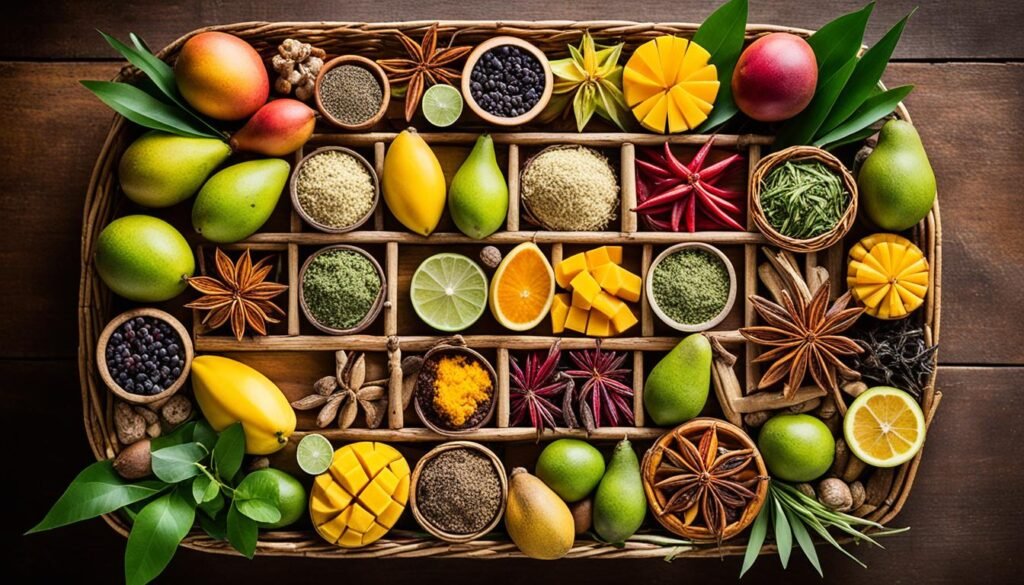
“Traditional foods and foodways are essential in reviving Indigenous culture and traditions, while also promoting healthy and sustainable dietary practices.”
As we embark on this journey of discovery, let us celebrate the diversity and importance of indigenous ingredients and local delicacies, and honor the rich tapestry of traditional food that nourishes both body and soul.
Ethnic Flavors: A Tapestry of Tastes
Across the globe, the world of traditional food is a vibrant mosaic of ethnic flavors, each with its own captivating story to tell. From the sizzling spices of Indian curries to the fragrant herbs of Mediterranean dishes, the diverse culinary traditions that have been shaped by the cultural, historical, and geographic influences of communities around the world are a true celebration of our shared gastronomic heritage.
Celebrating Diversity Through Cuisine
As the global appetite for ethnic flavors continues to grow, diners are becoming more adventurous and open-minded about exploring the rich tapestry of international cuisine. Restaurants that embrace this trend by adding diverse menu options not only attract a more diverse clientele but also contribute to a deeper appreciation for the cultural significance of traditional dishes.
Authenticity is key when it comes to showcasing ethnic flavors, and understanding the cultural nuances of each dish is essential. By hiring experienced chefs and sourcing the right ingredients, restaurants can transport their patrons on a culinary journey that celebrates the heritage and identity of different peoples. This approach not only enhances the dining experience but also plays a vital role in preserving the rich traditions that define our diverse gastronomic landscape.
| Ethnic Cuisine | Popularity Percentage | Fusion Cuisine Adoption |
|---|---|---|
| Mexican | 27% | 36% |
| Chinese | 24% | 41% |
| Indian | 18% | 29% |
| Italian | 15% | 33% |
| Middle Eastern | 11% | 25% |
As the global ethnic food market continues to grow, the opportunities for food entrepreneurs, chefs, and small businesses to showcase their cultural heritage and culinary expertise have never been more abundant. By embracing the diversity of traditional food and celebrating the unique stories behind each dish, we can create a richer, more inclusive dining experience that bridges cultures and fosters a greater appreciation for our shared gastronomic heritage.
“Each dish in the ethnic food market tells a unique story about the people, ingredients, and traditions behind it.”
traditional food: A Culinary Journey Home
As we embark on a culinary journey, the aromas and flavors of traditional food beckon us home, like a warm embrace from a cherished memory. In this exploration of nostalgic comfort foods, we uncover the stories that lie within each bite, reconnecting with the timeless traditions that define our cultural heritage.
Rediscovering Nostalgic Comfort Foods
The resurgence of traditional food has sparked a renewed appreciation for the simple pleasures of home-cooked meals. In a world that often moves at a breakneck pace, we find solace in the familiar dishes that transport us to cherished moments of the past. Whether it’s the traditional food passed down through generations or the comforting comfort foods that evoke a sense of nostalgia, these culinary treasures serve as a link to our culinary journey home.
As we savor each bite, we uncover the stories that lie within. From the time-honored techniques used to prepare these dishes to the personal histories that imbue them with meaning, we are reminded of the enduring power of food to nourish not just our bodies, but our souls as well.
“Food is not just fuel. It’s about family, community, and nourishing the soul.”
In this celebration of traditional food and its ability to connect us to our roots, we discover that the act of preparing and sharing these cherished recipes is a powerful testament to the resilience and richness of our cultural heritage. As we rediscover the comforting flavors of home, we find ourselves on a culinary journey that transcends time and space, reminding us of the timeless traditions that define our culinary identity.
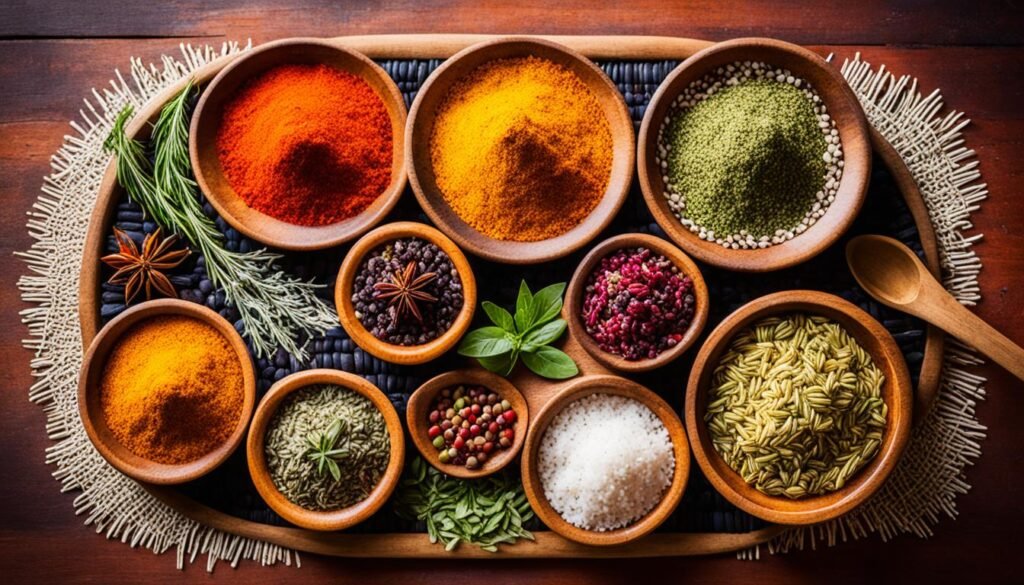
Honoring Traditions, Creating New Memories
As we delve into the world of traditional food, we discover that the true essence of these cherished culinary traditions lies not only in preserving the past, but also in the ability to adapt and create new memories. Witness how modern chefs and home cooks are honoring time-honored techniques and ingredients while infusing them with innovative twists, blending the old and the new to craft dishes that resonate with contemporary palates.
Explore how this delicate balance of respecting tradition and embracing change has led to the evolution of traditional food, ensuring its continued relevance and appeal for generations to come. Discover how the act of creating new memories around these time-honored dishes serves to strengthen the bonds of community and perpetuate the enduring legacy of traditional gastronomy.
During the holiday season, 94 million households in the US have at least one Christmas tree, reflecting a widespread family tradition. However, American families spend an average of 37 minutes of quality time together per day, indicating a low level of shared activities within families. To foster stronger connections, participating in a digital detox as a family can help shift the focus from devices to interpersonal connections, promoting healthier family dynamics.
Engaging in acts of altruism as a family can lead to positive physical and mental effects, as studies suggest. Family traditions like celebrating the full moon monthly or having a ritualistic fire ceremony on New Year’s Eve can also foster unique bonding experiences and seasonal acknowledgments. By starting a gratitude jar as a family, you can encourage expressions of appreciation and a sense of mindfulness within the household.
Cooking and sharing family recipes can help preserve a family’s cultural heritage and traditions. Hosting a regular game night can introduce an element of healthy competition and entertainment within the family unit, while creating a family scrapbook can serve as a tradition that promotes reflection on shared memories and special moments.
“Vibration Cooking is highlighted as a significant text in African American food, African diaspora food, and American food. Culinary historian Michael W. Twitty emphasizes the importance of energy in the cooking process.”
As we honor the traditional food and culinary traditions of the past, we must also embrace the opportunity to create new memories that will be cherished for generations to come. By striking a balance between preserving the old and welcoming the new, we can ensure that the rich tapestry of traditional gastronomy continues to evolve and captivate our senses, nurturing a sense of community and connection that transcends time.
The Importance of Preserving Food Heritage
Preserving our traditional food heritage is paramount in safeguarding the rich cultural identity of communities around the world. Traditional food is more than just sustenance – it’s a tangible expression of a people’s history, traditions, and values. From ancestral recipes to indigenous ingredients, the culinary tapestry of a region reflects the very essence of its cultural identity.
As globalization increasingly homogenizes cuisines, the preservation of traditional food becomes ever more crucial. By honoring the integrity of local gastronomy, we ensure the continued vitality of diverse culinary landscapes that make our world so vibrant and rich. This preservation work serves to strengthen the bonds of community, foster a sense of belonging, and pass down the cherished food heritage to future generations.
Safeguarding Cultural Identity Through Gastronomy
Food is a cornerstone of traditions, serving to unite people and strengthen cultural bonds within communities. Shared food experiences facilitate understanding and appreciation of diverse cultural backgrounds, while the act of preparing and consuming traditional dishes connects individuals to their cultural identity. Whether it’s the preservation of heirloom cooking techniques or the revival of treasured family recipes, maintaining the integrity of traditional gastronomy is essential in honoring the culinary histories that shape our world.
| Traditional Food Preservation | Impact on Cultural Identity |
|---|---|
|
|
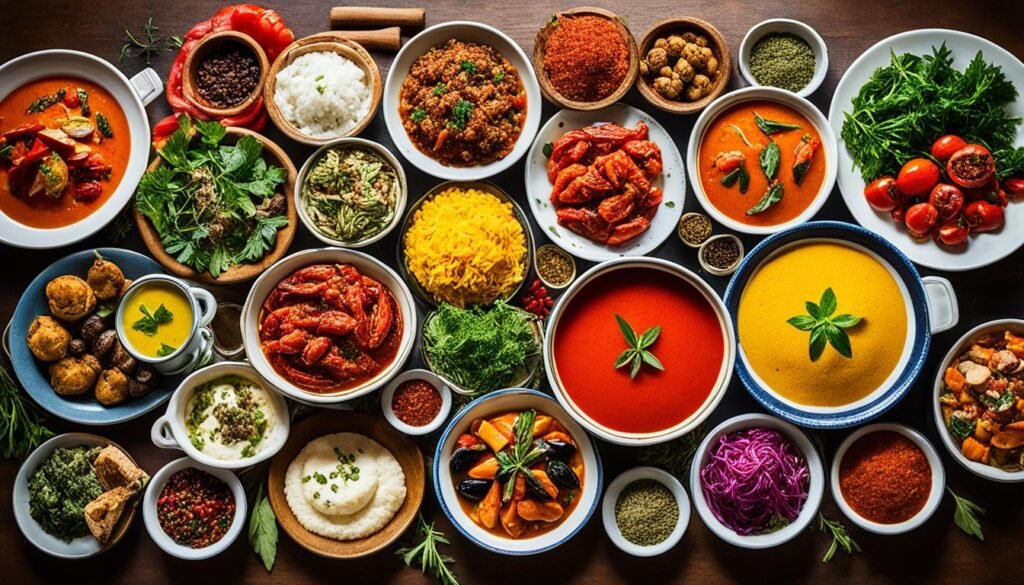
“Food is a crucial means of preserving cultural identity through traditional cuisine. Traditional recipes are passed down through generations to express cultural heritage.”
As we navigate the rapidly evolving culinary landscape, the preservation of food heritage stands as a beacon, reminding us of the deep cultural connections that sustain our diverse global community. By honoring the time-honored techniques, reviving treasured family recipes, and celebrating the use of local, indigenous ingredients, we not only nourish our bodies but also our collective cultural identity.
Conclusion
As we conclude our exploration of the captivating world of traditional food, I am left with a renewed appreciation for the power of culinary heritage to shape our cultural identity, foster community bonds, and nourish the soul. From the stories behind ancestral dishes to the artistry of heirloom cooking, I have witnessed the vital importance of preserving and celebrating these time-honored traditions.
Looking to the future, I am inspired by the innovative ways in which chefs and home cooks are honoring the past while creating new memories around the beloved flavors of traditional gastronomy. By embracing the diversity of ethnic cuisines and the bounty of indigenous ingredients, we can ensure that the rich tapestry of traditional food continues to thrive, serving as a testament to the enduring power of culinary heritage to connect us to our roots and to each other.
The journey through traditional food has not only expanded my palate but has also deepened my understanding of the cultural preservation and the future of this cherished culinary legacy. As I savor the final bites, I am left with a profound respect for the traditions that have shaped our diverse culinary landscape, and a commitment to carrying these flavors of home into the years to come.

